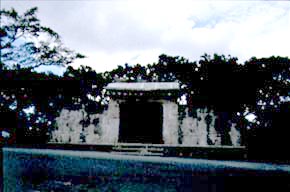|
At a meeting held in
late November in Cairns, Australia, the World Heritage Committee of the
U.N. Educational, Scientific, and Cultural
Organization (UNESCO) decided to register the ruins of ancient castles
and related properties of the Ryukyu Kingdom, now Japan's southernmost
island prefecture of Okinawa,
as World Cultural Heritage sites.
 Newly
added to the World Heritage
List are Shuri
Castle on the outskirts of Naha--the capital city of Okinawa--and
eight other monuments and historical and scenic spots. The castles and
other structures were all built between the latter half of the fourteenth
century, when local lords began unifying the Ryukyu Islands to construct
a kingdom, and the late eighteenth century. Newly
added to the World Heritage
List are Shuri
Castle on the outskirts of Naha--the capital city of Okinawa--and
eight other monuments and historical and scenic spots. The castles and
other structures were all built between the latter half of the fourteenth
century, when local lords began unifying the Ryukyu Islands to construct
a kingdom, and the late eighteenth century.
The Ryukyu Islands are located in the East China Sea, at the intersection between Japan, China, Korea, and Southeast Asian nations. The UNESCO committee has recognized the historical remnants of the Ryukyu Kingdam as cultural assets of these islands, which prospered for several centuries as an independent kingdom and developed a unique culture, taking advantage of its geographical location.
An Okinawan castle, called gusuku
(meaning a high place with an enclosure) in the Ryukyu dialect, is usually
an enclosed citadel constructed on a hill near a village. These were built
by local lords as defensive castles for the rule of their domains and
also functioned as sacred places for the worship of ancestors, which helped
to affirm the solidarity of the family clan. The Ryukyu Kingdom was unified
in 1429 under the influence of China's Ming dynasty, but it was conquered
by the Japanese domain of Satsuma (present-day Kagoshima Prefecture) in
1609 and became Okinawa Prefecture in 1879.
Shuri Castle, the early-fifteenth-century site located at the highest point of the Shuri hills, was destroyed during World War II, but extensive restoration work got underway in the 1950s, and reconstruction was completed in 1992. In July 2000, when leaders of the Group of Eight nations gathered in Okinawa for an annual summit meeting, they had a traditional Okinawan dinner at Shuri Castle.
 UNESCO's World Heritage convention was adopted in 1972 to protect cultural and natural sites as assets for all peoples of the world. The Ryukyu remains are the eleventh entry into the list from Japan. The previous listings include Buddhist monuments in the ancient Japanese capital of Nara and the Hiroshima Peace Memorial.
UNESCO's World Heritage convention was adopted in 1972 to protect cultural and natural sites as assets for all peoples of the world. The Ryukyu remains are the eleventh entry into the list from Japan. The previous listings include Buddhist monuments in the ancient Japanese capital of Nara and the Hiroshima Peace Memorial.
Photos: (top) Okinawa's Shuri Castle; (above) Sonohyan Utaki Ishimon, another newly registered site. (Okinawa Prefecture)
|

 Newly
added to the
Newly
added to the  UNESCO's World Heritage convention was adopted in 1972 to protect cultural and natural sites as assets for all peoples of the world. The Ryukyu remains are the eleventh entry into the list from Japan. The previous listings include Buddhist monuments in the ancient Japanese capital of Nara and the Hiroshima Peace Memorial.
UNESCO's World Heritage convention was adopted in 1972 to protect cultural and natural sites as assets for all peoples of the world. The Ryukyu remains are the eleventh entry into the list from Japan. The previous listings include Buddhist monuments in the ancient Japanese capital of Nara and the Hiroshima Peace Memorial.